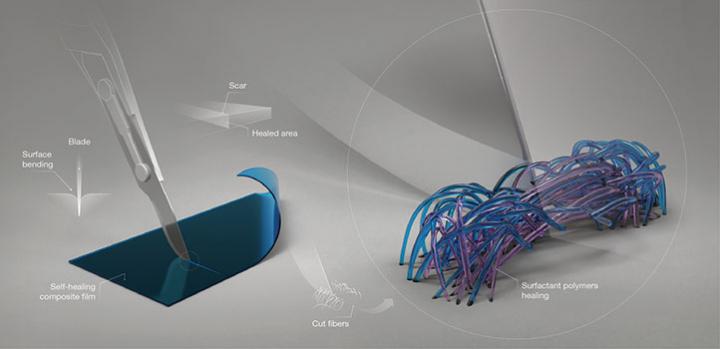
The mechanical and thermoelectrical self-healing process of the composite film.
Wearable electronics could be perpetually powered by stretchy, self-mending materials that use body heat to generate electricity. Three carefully curated organic compounds have been combined to develop a prototype thermoelectric material that is both stretchy and self-healing, can generate its own electricity, and is robust enough to withstand the stresses and strains of daily life.
Sensors worn on the skin or as implants are an increasingly popular way to gather biological data for personal and medical purposes. They can monitor valuable markers of human health, such as heart rate, blood pressure, brain activity, muscle motion, calories burned and the release of certain chemicals. The ultimate goal is self-powered wearable technologies, but these will require a reliable and durable electricity source.
Thermoelectric materials use temperature gradients to generate electricity. They have the potential to power wearable technologies using body heat, eliminating the need for batteries, but current materials lack the flexibility, strength and resilience to avoid being permanently damaged.
A team led by Derya Baran and Seyoung Kee at KAUST have blended the highly conductive thermoelectric polymer PETOT:PSS (poly(3,4-ethylenedioxythiophene) doped with polystyrene sulfonate), with dimethyl sulfoxide, an organic compound that boosts the performance of PETOT:PSS, and Triton X-100, a sticky, gel-like agent that encourages hydrogen bonding with PETOT:PSS. “This final ingredient was essential for providing the stretchy and self-healing properties we needed,” says Kee.
The researchers used a 3D printer to deposit their mixture into thick layers and then tested the thermoelectric performance of these films under duress. First, they found that a temperature difference of 32 degrees Celsius between the two sides of the film generated the maximum power output of 12.2 nanowatts.
The team then tested the self-healing behavior of the films by cutting them in half with a razor blade while they powered an LED light. “Amazingly, the light did not go out during or after cutting,” says Kee. “I repeated the cut ten times, but it continued to self-heal in less than one second and retained 85 percent of its power output.” Additionally, when they stretched the film to around a third longer than its original size, it still provided a stable power supply.
“Wearable electronics are under continuous strain, and their power supply is prone to breaking,” says Kee. “Our material can provide constant and reliable power because it can deform, stretch, and most importantly, heal itself.”
Twelve nanowatts is not enough to power many devices, except perhaps highly efficient biosensors and transmitters, but it is a promising start. “We have shown that such materials can be made easily using 3D printing, which is a very popular and practical technology” says Kee. “Next, we must find materials with even better thermoelectric properties so that we can generate greater power in the near future.”
###
Media Contact
Carolyn Unck
[email protected]
Original Source
https:/
Related Journal Article
http://dx.




